Plants are nature’s best way to add exquisite tints in your homes, and here are 33 different types of Colorful Houseplants to make it happen!
Houseplants are the best way to add a touch of greenery in the homes. Picking a variety that offers a dash of colors in the foliage can make it a tad more interesting for your rooms! Here are some best Colorful Houseplants, which you should grow indoors to fill your interior with the colors of nature!
Check out our article at tricolor houseplants here
1. Pink Polka Dot Plant
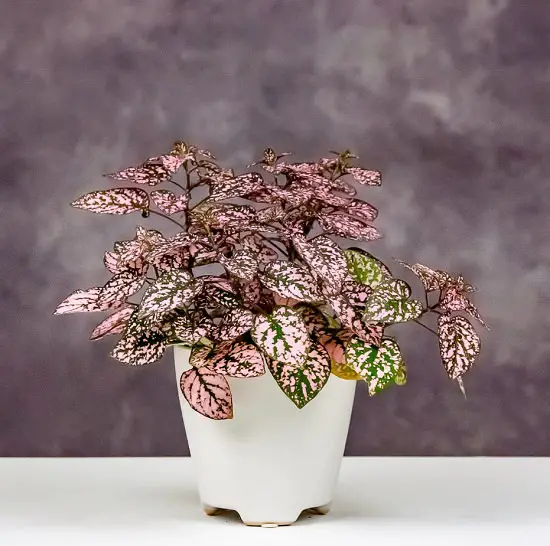
Botanical Name: Hypoestes phyllostachya
The pink leaves of Hypoestes phyllostachya have lovely, dark green patches, making it one of the best colorful houseplants! The vibrancy of its foliage further intensifies under the morning sunlight. Some varieties like Carmina come in purple and scarlet shades as well.
Tip: Feed this plant with weak strength liquid fertilizer once in 2-3 weeks during the growing season.
2. Polka Dot Begonia
Botanical Name: Begonia maculata
One of the most gorgeous indoor plants and our Editor’s Pick–Polka dot begonia deserves to be on this list. This fancy houseplant has silver spots on leaves and red undersides. It’s definitely not easy to grow but worth the efforts.
Tip: Provide it bright indirect sunlight and loamy soil.
3. Coleus
Botanical Name: Plectranthus scutellarioides
The leaves of Coleus looks like a color-filled palette, with contrasting edgings, giving it a very stunning look. Its color will make you fall in love with it all over again, every time you look at it!
Tip: Keep it in a warm and bright place for optimum growth.
4. Croton
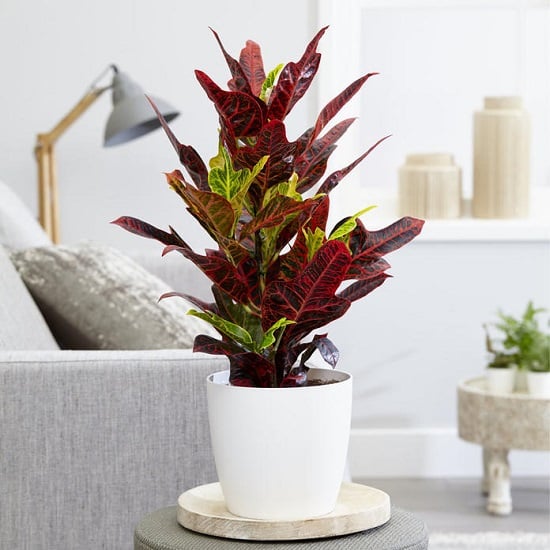
Botanical Name: Codiaeum variegatum
Croton tops the list of colorful houseplants due to its multicolor leaves, beautifully lined with blotches and stripes. Happily growing in partial sunlight, the croton plants indoors can make a bold statement in your house.
Tip: Petra croton is an ideal variety for indoors, as it can stay in low light also.
5. Nerve Plant
Botanical Name: Fittonia albivenis
The markings on the pink-green foliage of a Fittonia plant are perfect for adding an appeal to any room. They look especially mesmerizing when the light falls on their leaves, so put them near a bright window. Some of its varieties like Pink Angel Fittonia have pink veins also.
Tip: The filtered and bright light keep this plant happy, so keep it in 2-4 hours of sunlight.
6. Purple Velvet Plant
Botanical Name: Gynura aurantiaca
As the name suggests, the purple-green leaves of this houseplant are covered with lacy purple hair, giving it a velvety texture. This houseplant is good for hanging baskets, too, and can be easily multiplied through stem cuttings.
Tip: Fertilize this houseplant with a water-soluble fertilizer having an NPK ratio of 3:1:3 or apply balanced fertilizer.
7. Peperomia
Botanical Name: Peperomia
The fleshy leaves of Peperomia, growing on trailing stems, makes it a perfect choice for hanging baskets. Its variegated leaves can either be of heart or oval-shape. Some varieties like watermelon and metallic peperomia have silver blotches on burgundy and green leaves.
Tip: For growing peperomia indoors, an east-facing window is an ideal location.
8. Rex Begonia
Botanical Name: Begonia rex
Rex Begonia can be an excellent addition to your colorful indoor plants’ collection, as its foliage offers an array of colors ranging from purple, pink, green to silver. Some of the best varieties to grow are-Red Delta, Duarten Rex, Ballet, Pink Charming, Fairy, Red Kiss, and Tornado.
Tip: Prefer keeping it near a window that receives several hours of mild, direct sunlight.
9. African Mask
Botanical Name: Alocasia amazonica
The big, dark green foliage of this houseplant is lined with bold, white veins, making it an excellent centerpiece choice. The rapid growing Alocasia does well when exposed to morning sunlight.
Tip: This plant has calcium oxalate crystals that can cause penetration and irritation of the mouth, so keep it away from your pets to avoid them chewing on its leaves.
10. Red Aglaonema
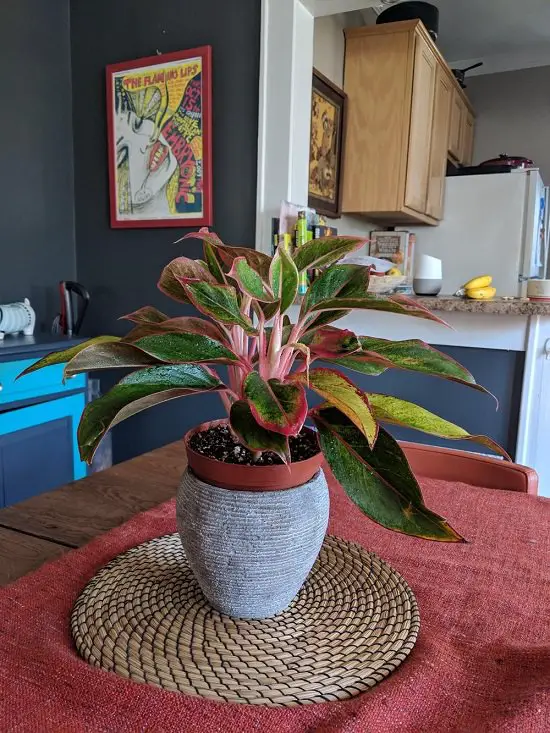
Botanical Name: Aglaonema commutatum
Red Aglaonema is a popular good luck plant, which is also super easy to grow. This ornamental plant has green to silver foliage with a hint of red. Its dark-green varieties do well in the shade, while the variegated varieties need diffused sunlight.
Tip: It is also popular as an air-purifying houseplant.
11. Desert Gems Cacti
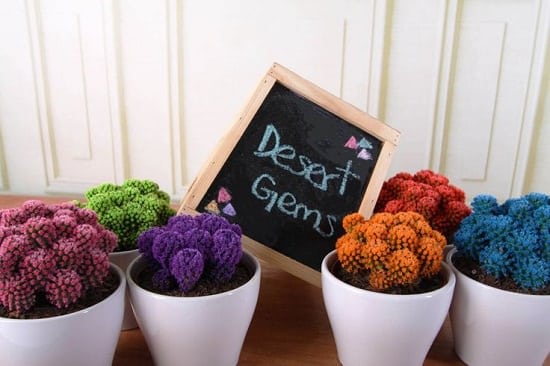
The desert gems cacti from Costa Farms are bold tabletop succulents. Their vibrant look is, of course, not natural, but this doesn’t affect their ability to photosynthesize according to the grower. This slow-growing cactus is an ideal choice for busy gardeners.
12. Snake Plant
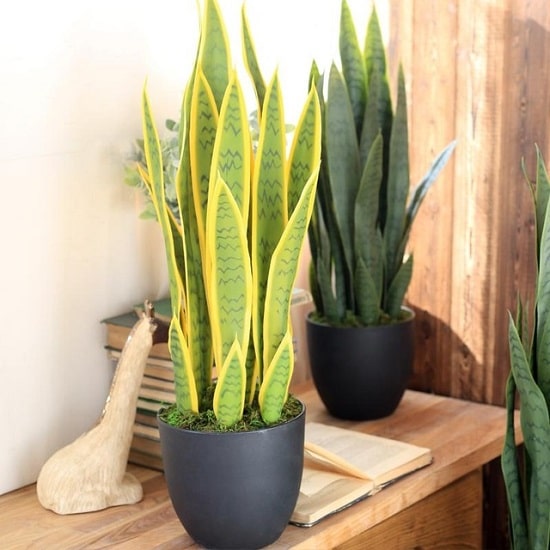
Botanical Name: Sansevieria trifasciata
There are very few alternatives to this houseplant, as it not only brings greenery in the homes but also purifies the indoor air as well! The snake plant has long, upright green leaves with a bold white or yellow border. Some of the best colorful varieties include- Black Gold, Futura Robusta, Gold Hahnii, and Whitney.
Tip: You must avoid overwatering this plant; let the water dry out between the watering cycles.
To know more about the snake plant benefits, click here!
13. Calathea
Botanical Name: Calathea zebrina
Calathea has bold and beautiful foliage, without any flowers! With silver brushmarks over the shiny green leaves having scalloped edges and a stunning shade of burgundy-purple beneath, this is one of the best colorful houseplants in the list! Beauty Star, Corona, Eclipse, Freddie, and Peacock is the best varieties to grow.
Tip: Calathea needs day long, indirect sunlight, and a humid environment to thrive.
14. Madagascar Dragon

Botanical Name: Dracaena marginata
The colorful leaves of the red-edge dracaena have variegated color patterns, slightly arching on the sturdy stems, look no less than a work of art! Since it is a large indoor houseplant, you can place it in your living room to create a bold statement.
Tip: Feed this houseplant 2-3 times during a growing season with regular fertilizer.
15. Aluminum Plant
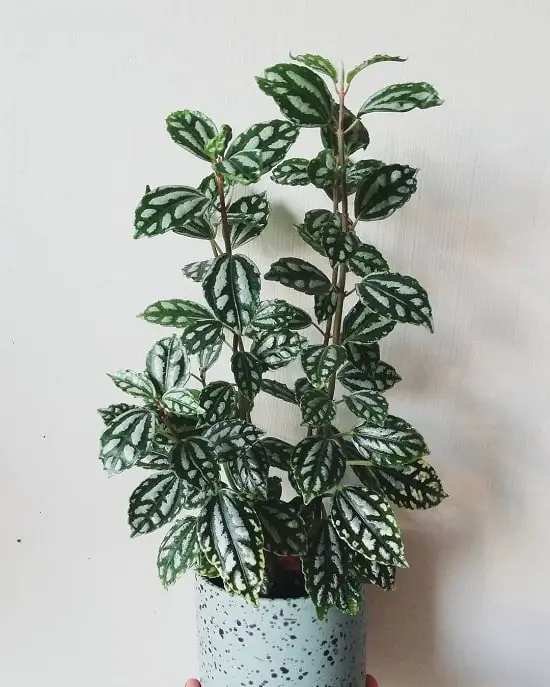
Botanical Name: Pilea cadierei
With very shiny foliage, having almost a liquid-like finish on its surface, the aluminum plant creates a rhythm of a beautiful tapestry with its leaves. This fast-growing houseplant reaches a height of 6-12 inches. It loves bright light nurturing, but can tolerate low lights as well.
Tip: Keep it under the bright filtered sun and in partial shade during summers.
16. Waffle Plant
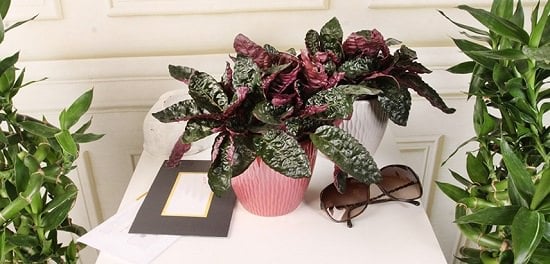
Botanical Name: Hemigraphis alternata
With an exceptionally graceful bicolor foliage, the Waffle Plant will amaze you by its gray-green color and dark-purple hues. Like other colorful houseplants, it also requires a few hours of direct sunlight to maintain its shade of color.
Tip: Use a general-purpose fertilizer, once a month during the growing season.
To know more varieties of purple color houseplants, click here!
17. Bromeliads
Botanical Name: Bromeliaceae
Wondering how this plant came into this list? The answer lies in its long-lasting, exotic flowers, coming in red, orange, and pink, with strappy green leaves. It also improves the quality of indoor air. Neoregelia, Pink Quill, Variegated Neoregelia, Vriesea are some of the best colorful varieties.
Tip: To learn about growing and caring for bromeliads, click here!
Check out our article on different types of Bromeliads here!
18. Hedgehog Cactus

Botanical Name: Echinocereus
Hedgehog is covered with pink, white, or yellow spines. It can be a showy addition to your houseplant collection, standing out especially with those big blossoms, coming in coral pink, scarlet, purple, and orange shades, that can take up the entire side of a pot.
Tip: It loves a warm environment to thrive. Place it near a sunny window for the best growth.
19. Prayer Plant
Botanical Name: Maranta leuconeura
Prayer plant looks appealing due to its large, velvety and variegated leaves, and comes in a dark green color, with textured, contrasting veins. Red Prayer plant has red veins on the green leaves, whereas the Lemon prayer carries yellow veins that run in the middle of leaves.
Tip: Exposure to bright morning and evening sun, is ideal for its growth.
20. Purple Clover
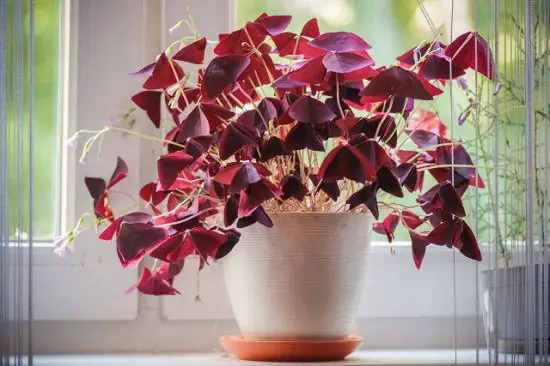
Botanical Name: Oxalis triangularis
If you want to grow a black indoor plant, you’re absolutely going to adore the Purple Shamrock! The deep purple, triangular-shaped foliage looks almost black from a distance, and its floppy leaves give it an appearance of fluttering butterfly!
Tip: Keep it at a bright spot under the temperature range of 60-75F (15-25C)
21. Iron Cross Houseplant
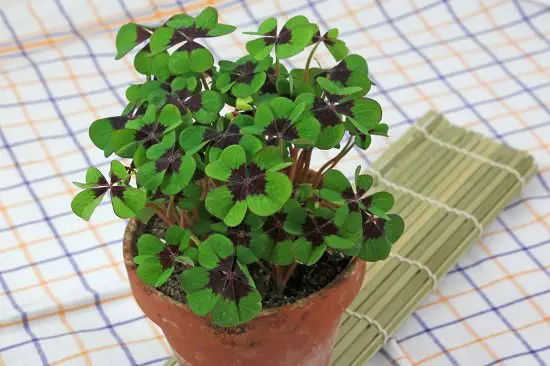
Botanical Name: Oxalis tetraphylla
This houseplant is famous for its heart-shaped leaves with purple, maroon, and black markings at the center of the foliage. Their leaves close up in the night time, taking the shape of a closed umbrella. It is also popular as a good luck plant.
Tip: It is well-suited for partial shade, but can stay in full sun exposure as well.
22. Wandering Jews
Botanical Name: Tradescantia zebrina
When it comes to growing colorful houseplants, Wandering Jews top the list! Its foliage has pointy edges, which can be variegated or solid-colored, depending on the cultivar. It also produces flowers during spring.
Tip: Provide it a few hours of direct sunlight for the best markings on the foliage.
23. Hawaiian ti Plant

Botanical Name: Cordyline fruticosa
Also known as the Hawaiian good luck plant, the maroon leaves of Hawaiian ti have pink, cream, and white streaks. Growing up to 3-4 ft height, it is also super easy to maintain and can add a distinctive appeal to your house with its tall, vivid leaves.
Tip: Bright and filtered light is the best exposure, but avoid keeping it in direct sun, as it can burn its leaves.
24. Rubber Plant
Botanical Name: Ficus elastica
Glossy and oblong leaves of rubber plants are of dark green or maroon color, while the variegated rubber plant comes with yellow, cream, pink, and white patches on the foliage. It can grow up to 6-8 feet tall indoors. It’s is ideal for beginners due to low-maintenance nature.
Tip: Keep rubber plant at an east-facing window, as it grows best in the morning sun.
To know more about growing and caring for the rubber plant, click here!
25. Persian Shield
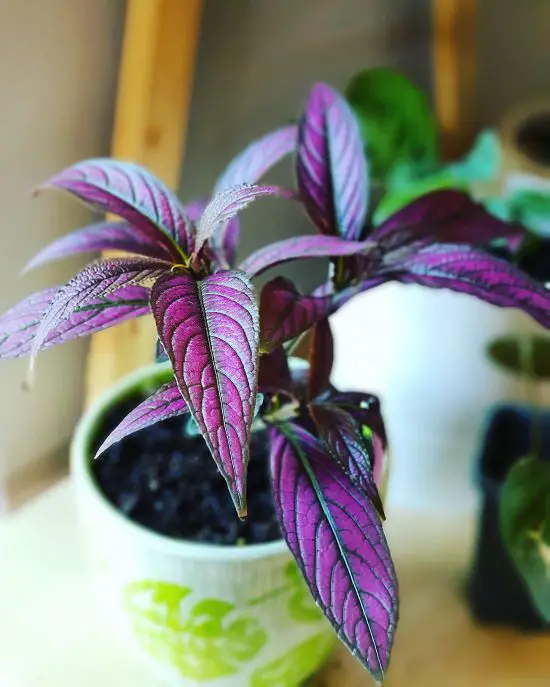
Botanical Name: Strobilanthes dyeriana
The dark purple leaves of Persian Shield with green veins running in the middle will make you fall in love with its foliage! The foliage has an unmistakable, iridescent shine that makes it one of the best colorful houseplants! Keep it near a south or west-facing window, in 3-4 hours of sunlight for optimum growth.
Tip: Use a balanced liquid fertilizer every two weeks.
26. Caladiums
Botanical Name: Caladium spp
With striking lines and spots on the heart-shaped foliage, the Caladiums are surely going to make your room stand out! Its pattern explodes in colors, making it look like an artist’s imagination on a canvas.
Tip: They love a humid environment and tolerate the bright, indirect sun.
27. Crown of Thorns

Botanical Name: Euphorbia milii
Crown of thorns is one of the best flowering houseplants. Deep pink flowers have a propeller-like appearance to them and, when combined with its bright leaves, looks merely outstanding!
Tip: Keep the plant in 3-4 hours of bright, direct sunlight.
28. Ruby Ball Cactus

Botanical Name: Gymnocalycium mihanovichii
The moon cactus is a popular colorful house plant with a top coming in bright, neon pink, yellow or orange colors that resemble round looking balls or a star. They do best in bright sunlight but avoid keeping them in direct sun for more than 4-5 hours.
Tip: Use a pot with drainage holes to prevent standing water that can cause root rot.
29. Clivia

Botanical Name: Clivia miniata
Quite famous as easy to grow houseplants, what makes them beautiful is their cluster of flowers made up of individual, star-shaped petals in brilliant orange to red color. Even when they’re not flowering, their foliage makes it up for the beauty! Clivia is a poisonous plant because of the alkaloid lycorine, so keep your pets away.
Note: Fertilize them once a month using balanced fertilizer for the best growth.
30. Poinsettia
Botanical Name: Euphorbia pulcherrima
Also popularly known as the Christmas Beauty Queen, Poinsettia’s foliage strikes an adorable balance between a variety of shades like white, red, pink, and bi-colors, making it one of the best looking colorful houseplants.
Tip: Keep the plant in indirect sunlight for 6-7 hours for the best growth.
31. Pencil Cactus
Botanical Name: Euphorbia tirucalli
The Milk Bush, as it’s popularly known, is a stem succulent that looks astonishing with its pencil-like, uneven foliage. It can grow up to 6 feet tall indoors and is the best plant to add color to your rooms! But beware, its sap is toxic for both humans and animals.
Tip: Keep the plant near a sunny window for 3-4 hours to get the red color. Repot it when you find it rootbound.
32. Strawberry Saxifrage
Botanical Name: Saxifraga stolonifera ‘Tricolor’
This stemless plant is perfect for indoor hanging baskets. The main attraction is its red wire-like hanging stolons that bear mini plantlets, which resemble strawberry runners.
Tip: While indirect sunlight is sufficient, it grows best when exposed to a couple of hours of direct sun.
33. Pilea ‘Dark Mystery’
Botanical Name: Dark Mystery Pilea
This variety has textured leaves of chocolate color. Broad silver strip over each leaf makes it more intriguing. Its compact nature makes it suitable for tabletops, shelves, and narrow windowsills.
Tip: While this plant can tolerate low light conditions, be careful with watering and water only when the soil is dry.


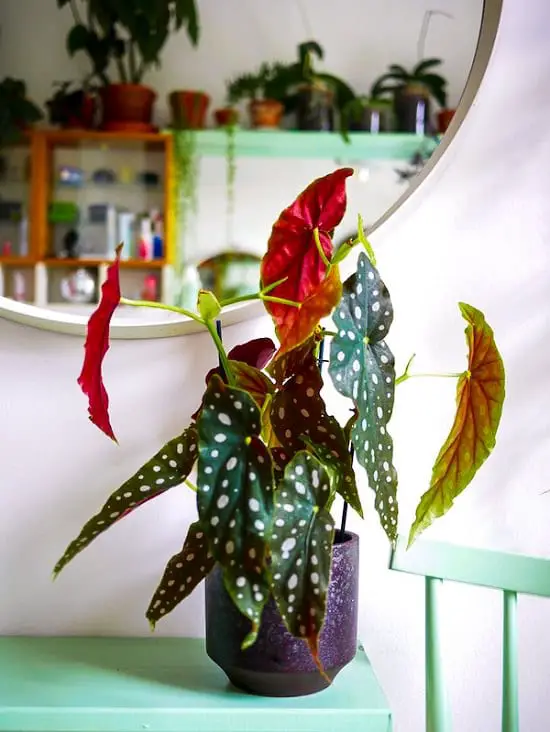

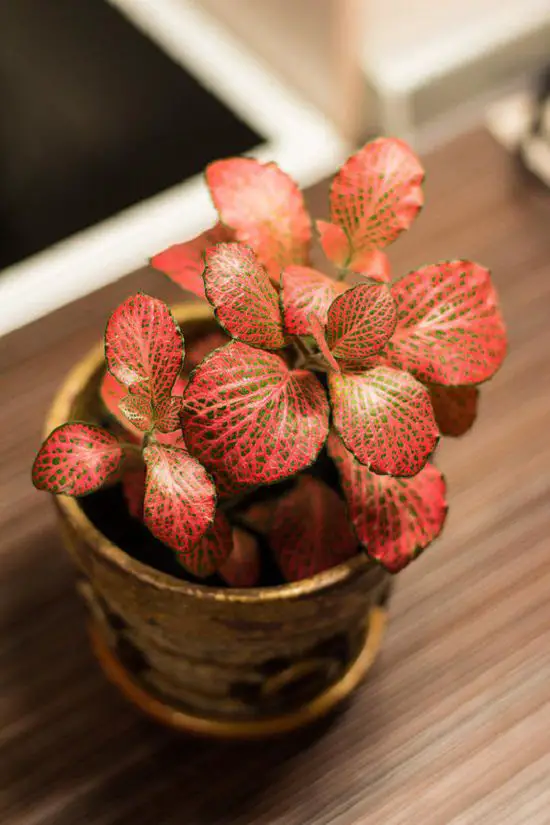


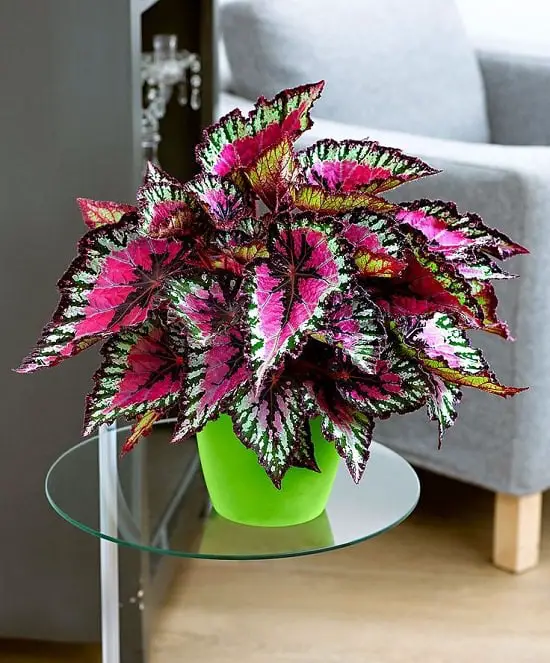
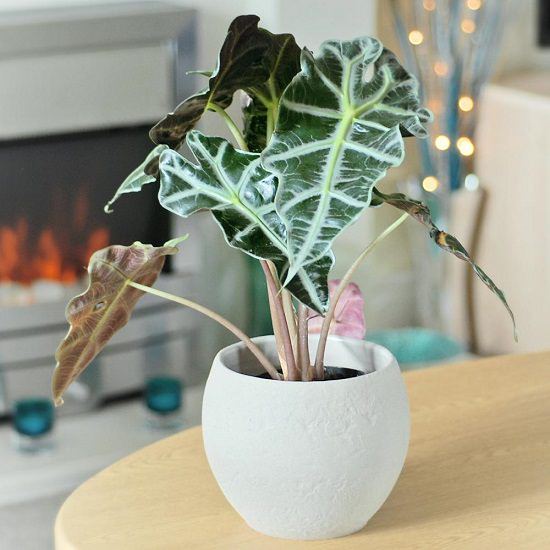
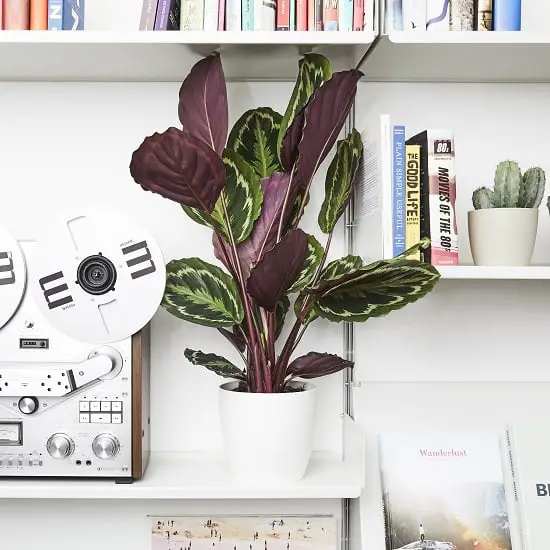
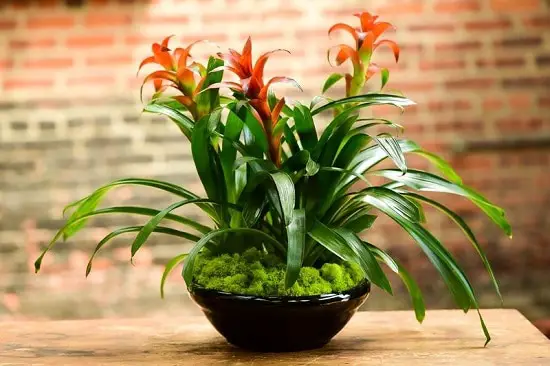
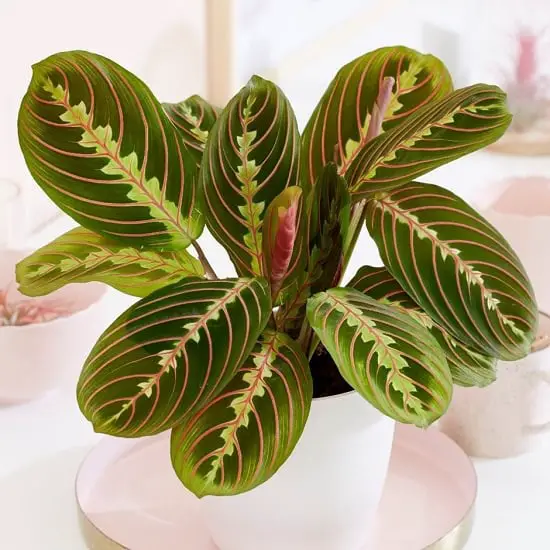

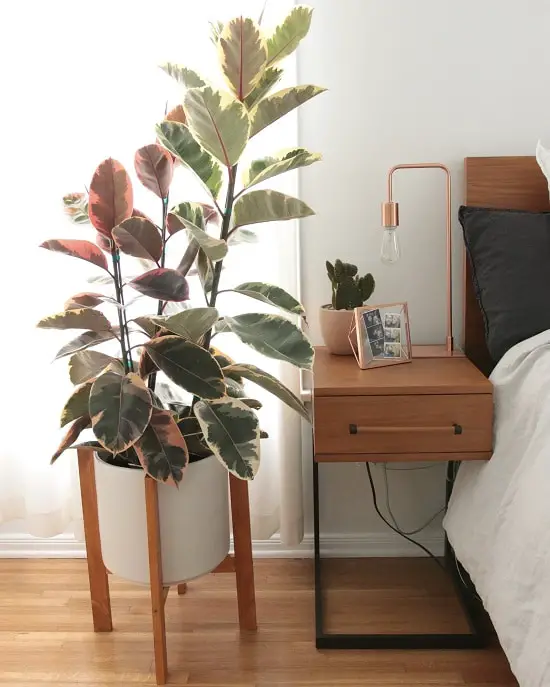


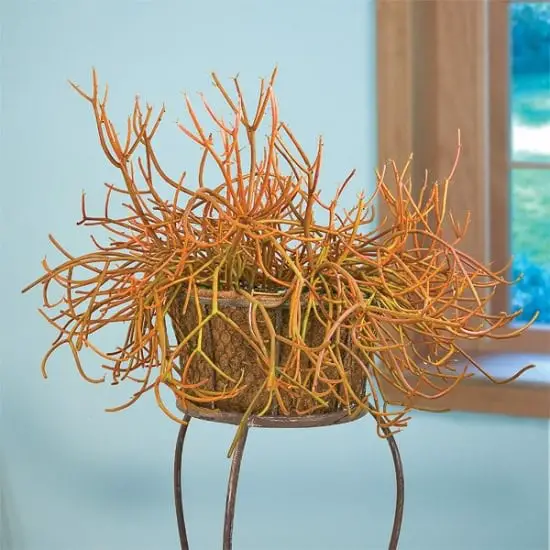
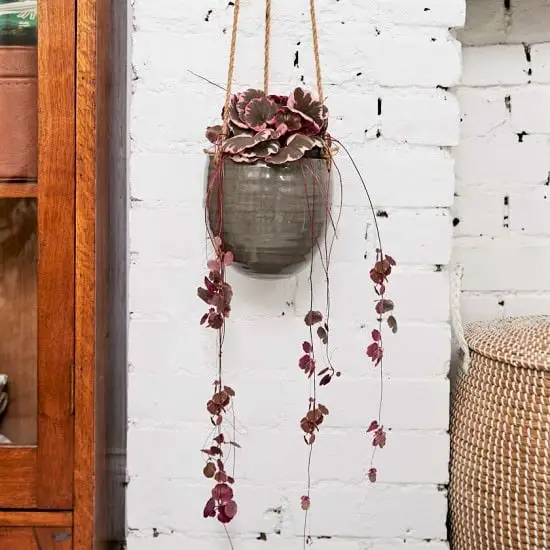
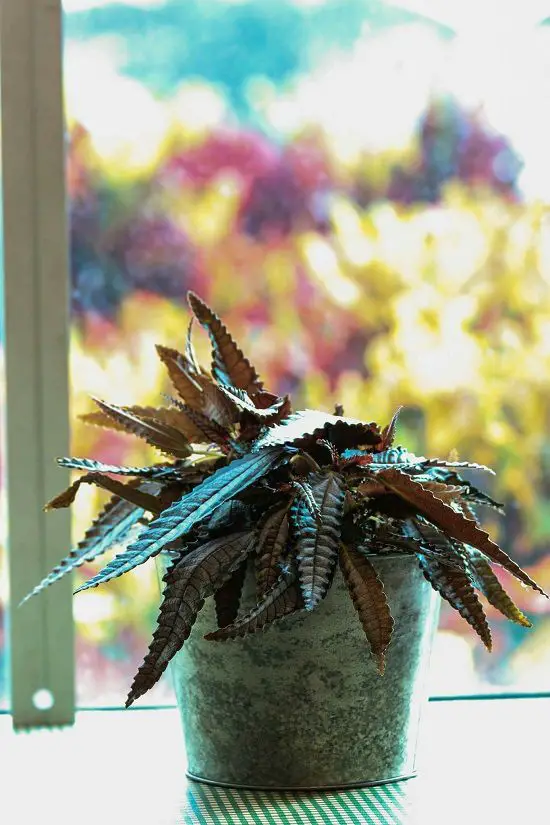

where can I buy the caladium
Wonderful information for houseplant lovers.